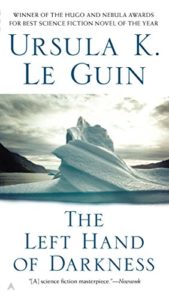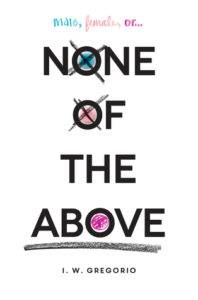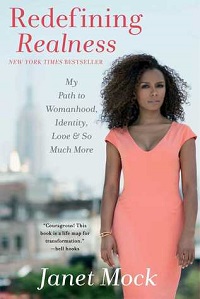Okay, so, I complain a lot about how difficult it is to find novels that explore gender. It can be really frustrating to feel like there isn’t anyone willing to publish books about gender identity that challenge society’s ideas about the gender spectrum, and instead reaffirm that we live in a world dominated by the binary. For those of us who fall outside of the binary, it is one part of a constant struggle to be seen as valid and present in this world. But the good news is, there is hope, and there are writers working to fill this void.
When we talk about gender identity, we are often faced with misunderstanding and society’s feverish obsession with rigid categories: if a person isn’t immediately identifiable as one thing or another, it’s like society doesn’t know what to do and goes haywire. Gender-nonconforming folks are constantly othered and ostracized for not fitting in. Layer on issues of race, class, and sexuality, and we’ve got ourselves a whole pile of problems that hinder us from leading comfortable, safe lives.
These books about gender identity explore the issues presented by gender essentialism and the struggles of individuals who fight against that and seek a life as their true, beautiful selves.
Fiction Books About Gender Identity
Orlando by Virginia Woolf
One of the classics of queer literature, Virginia Woolf’s Orlando stands singular amongst its peers as a novel centering on gender and identity. For Woolf, for whom gender was a constriction both in terms of her career and her romantic life, Orlando seems an exploration of a world in which the binary is infinitely more flexible, a future in which gender boundaries are broken. With a protagonist who changes sex mid-novel and explores relationships with partners of both genders, and even includes a singular they pronoun, Orlando is one of the most important novels we have about gender.
Tipping the Velvet by Sarah Waters
While this novel primarily focuses on lesbian relationships in Victorian London, many of its characters explore gender through drag. The main character, Nan, begins performing in drag with her lover, and eventually slides into a male persona outside of the theater as well. It is certainly a commentary on gender as performance and learned characteristics, as well as how felinity and masculinity operate in society.
Middlesex by Jeffrey Eugenides
This is often a bit of a controversial novel, given that it isn’t #ownvoices and has faced some criticism for the portrayal of its intersex main character, Cal. Middlesex also progresses into issues of immigration, culture, and family, but primarily explores Cal’s discovery of their gender identity and their coming of age. Cal (or Callie) is raised as female but later assumes a male identity and presentation, and also has sexual encounters with multiple genders. Definitely a novel not to be missed, but perhaps read with a critical eye.
 Left Hand of Darkness by Ursula K. Le Guin
Left Hand of Darkness by Ursula K. Le Guin
Science Fiction has often been a bit of a haven for novels that explore gender, and Left Hand of Darkness reigns supreme among them. A futuristic world with ambisexual inhabitants provides a setting in which the culture surrounding gender is explored, and certainly illuminates the way those from more strictly gendered societies interact with an idealized gender-neutral culture. It also postulates what the world would be like without gender roles, a perfect example of sci-fi laced with social commentary.
Confessions of the Fox by Jordy Rosenberg
Rosenberg’s Confessions of the Fox is historical fiction with dueling narratives—primarily that of the famed London thief Jack Sheppard, whom the novel reimagines as AFAB, and underneath, the narrative of a modern-day professor, also trans, who is authenticating the found manuscript about Sheppard. The novel is not only about the trans experience, but a commentary on the historical erasure of trans folks and people of color.
Stone Butch Blues by Leslie Feinberg
This is definitely a classic novel that explores butch identity and the blurred lines between masculine and feminine. The novel’s protagonist, Jess, is found dressing in her father’s clothes and is sent to a psychiatric ward by her parents. Eventually she finds an affirming community of queers, drag queens, and other butches who help her learn how to navigate the world, and later begins to take testosterone and pass as male (and even later, stops this process and lives gender-neutral). Though there is trauma, Jess and her community fight for their rights and validity, all while navigating romance and relationships.
George by Alex Gino
George is probably one of the most important books about gender because not only does it center of the story of a child dealing with gender identity, but it is written for children as well, with the intention of helping them to understand gender presentation at a young age. The story’s protagonist is AMAB and struggles with being seen as her true self, Melissa. This book was definitely a spark for a wave of books geared towards young readers, and helps young people struggling with gender to feel seen and valid.
Lizard Radio by Pat Schmatz
Using sci-fi themes, Lizard Radio explores gender fluidity and the constraints that society places on those who don’t fit within the binary of male/female. Its main character, Kivali, feels like she has to hide and fit in, but feels increasingly unable to do so. However, Kivali exists in a society with oppressive expectations for its citizens, and the pressure to conform is immense. This is definitely a story for people who feel like exploring their true selves might be unsafe, and who wish for a more accepting world.
When the Moon Was Ours by Anna-Marie McLemore
With McLemore’s trademark lush and fantastical prose, this novel explores gender with magical realism and carefully researched cultural markers. One of the main characters, Sam, is trans, and struggles with the expectations that he will assume a feminine identity once he comes of age, after being raised as a boy as part of bacha posh, a Pakinstani & Afghan practice in which families without a son will raise the eldest daughter as masculine until they are of marrying age. It’s a beautiful story about friendship and love, and most especially about how outsiders support each other and come together.
 Girl Mans Up by M-E Girard
Girl Mans Up by M-E Girard
A novel about a young person fighting for validity and respect, Girl Mans Up centers on a butch lesbian protagonist. Pen has always presented more masculine but faces more criticism as she grows older, both from her parents and from peers. The novel explores gender expectations and performance, and the emotional toll these expectations can take on someone who doesn’t fit in a specific box. It’s a story about not compromising oneself, and about knowing who you are even when others want you to be otherwise.
Alex As Well by Alyssa Brugman
Another novel featuring an intersex protagonist, this story focuses on AMAB Alex, who decides to start presenting feminine, which presents logistical complications when she enrolls in a new school. This brings up issues many trans/gender-nonconforming youth face as they simply try to exist in society. The importance placed on gender markers when it comes to birth certificates, licenses, etc. becomes a fight for rights that others take for granted. It also deals with Alex’s parents, who do not support her decision to present female, and the tension this brings into the family. This might be triggering for some, but ultimately important in the way it presents a protagonist who just wants to be accepted.
 None of the Above by I.W. Gregorio
None of the Above by I.W. Gregorio
Homecoming queen Kristin discovers she has androgen insensitivity syndrome, an intersex condition, after a painful attempt at having sex. Of course, Krissy’s social life changes significantly once her condition becomes known, something familiar to lots of queer/gender-nonconforming kids, but this allows her to make new friends and discover who she really is. It is a hopeful story that is an exploration of gender and the body, and the important distinction that sex and gender presentation are two very different concepts that don’t always correlate the way society expects them to.
How Beautiful the Ordinary: Twelve Stories of Identity ed. Michael Cart
This anthology features stories by some incredible writers like David Levithan, Jennifer Finny Boylan, Emma Donoghue, Francesca Lia Block, and Gregory Maguire, all of which explore elements of queerness and gender identity. The beauty of an anthology is that there’s something for everyone, and these stories, while varying in genre and theme, all speak to the desire for acceptance and struggles that LGBTQ+ people face.
NonFiction Books About Gender Identity
Gender Trouble: Feminism and the Subversion of Identity by Judith Butler
A seminal text in the fields of feminist, gender, and queer studies, Judith Butler’s book presents some of the most essential concepts that influenced modern understanding of sexuality and gender. Butler critiques the construction of sex and gender in society and takes an intersectional approach, proposing the concept of gender expression as separate from biological sex, and that expectations of gender vary across cultures. This is a theory-heavy text, but foundational.
Female Masculinity by Judith Halberstam
I want to note here that since the author now goes by Jack Halberstam and uses both masc and femme pronouns, though the book is still published under “Judith.” This book explores the construct of masculinity within society and gender performance, especially as it pertains to lesbians and trans individuals. The book works through the concepts of tomboys, butches, and drag kings, passing, and society’s policing of gender.
She’s Not There by Jennifer Finney Boylan
Boylan is a prominent novelist and writer, and her memoir details her transition at a later stage in life than we often see—after marriage and children. The memoir explores the way her transition changed Boylan’s relationships with friends, colleagues, and her wife, as well as her writing career. It’s a touching story and critical in that it explores transition in adulthood, and the freedom of being one’s true self.
 Redefining Realness by Janet Mock
Redefining Realness by Janet Mock
Janet Mock is one of culture’s most prominent trans activists, and the first black trans woman to direct an episode of television through her work on the series Pose. Her memoir details her experience transitioning with an intersectional focus: growing up both poor and black presents unique struggles, and Mock’s narrative is full of trauma and heartbreak. But through it all she thrives and remains true to herself. Mock explores concepts of femininity and culture, while providing an honest look at the hardships she faced.
Gender Outlaw & Gender Outlaws: The Next Generation by Kate Bornstein
Gender theorist Kate Bornstein’s genre-defying memoir explores nonbinary gender and rebukes a society that tries to force people to identify as either man or woman. A sharp critique of the binary, Gender Outlaw discusses gender and transition, as well as desire and sexual orientation, fluidity, and performance. Its follow up, Gender Outlaws: The Next Generation, is a collection of essays by other prominent trans and gender-nonconforming critics that offers a more intersectional perspective.
The Last Time I Wore A Dress by Daphne Scholinski
Potentially triggering, this memoir explores the psychiatric diagnosis of Gender Identity Disorder and its treatment in psychiatric hospitals during the 1980s. Scholinski details her experience as a young girl, suffering under the pressures of a society that demands conformity. After being determined “not feminine enough,” Scholinski was sent into treatment which involved lessons in femininity performance. It is definitely a tough read, but an important take on the way society views those outside of the binary.
Nobody Passes: Rejecting the Rules of Gender and Conformity ed. Matt Bernstein Sycamore
Each essay in this collection confronts issues of “fitting in,” dealing with issues of presentation and combating societal expectations. It also provides intersectional narratives that deal with themes of religion, sex and sex work, family, class, and race. It is definitely a critique on the way culture expects people to fit into neat categories, but no one really does.
Learn more:
- 2019 Most Anticipated LGBTQ+ Reads
- THEY/THEM: 5 Non-binary and Genderqueer Writers
- Trans SFF for Transgender Day of Remembrance
Source : 20 Books About Gender Identity, Fiction And Nonfiction









